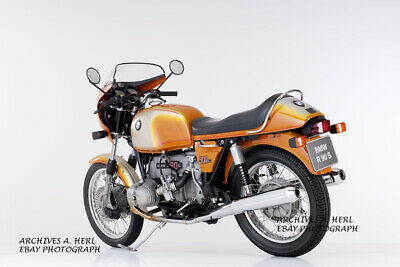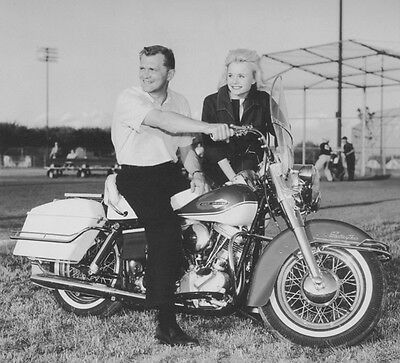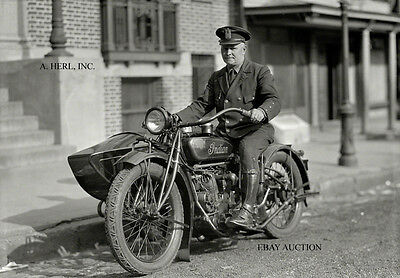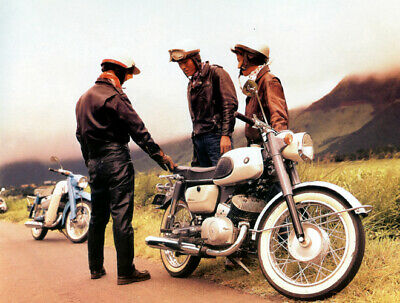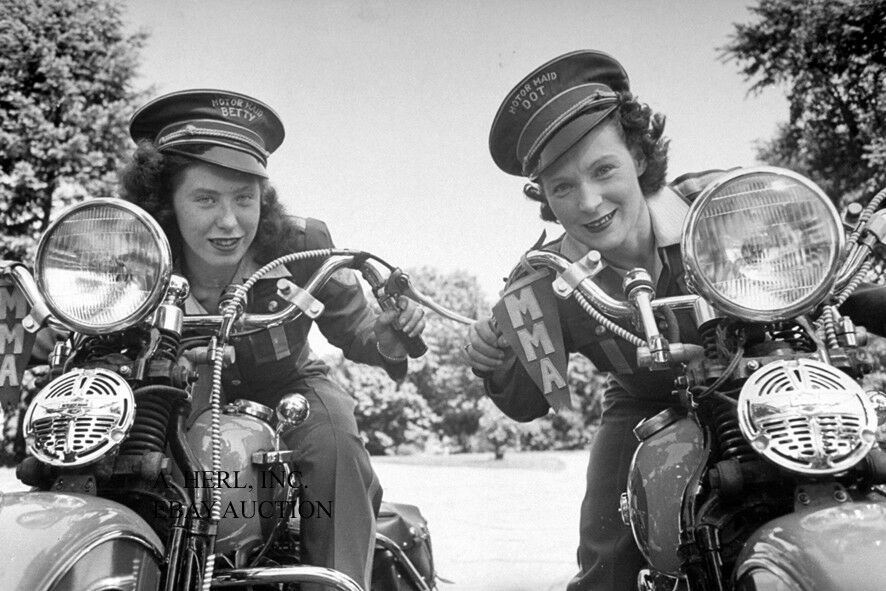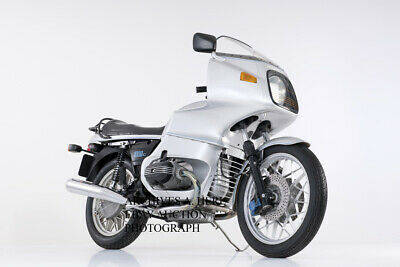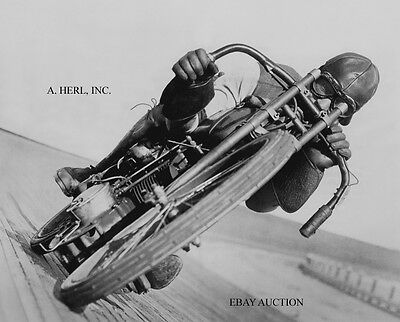-40%
BMW R 90 S Daytona 1973 introduction BMW R90S motorcycle press photo 1
$ 5.14
- Description
- Size Guide
Description
A superb and rare photo, made from the original negative, of the greatBMW R 90 S Daytona
, of
1973
, photographed during a studio publicity shoot late 1972 for the introduction campaign of the new model late 1972. The R90S Daytona is considered the first 1970s superbike style motorcycle from the famous Bavarian motorcycle manufacturer. It was styled by Hans Muth, who also designed the BMW R65 LS and later on the Suzuki Katana.
The strikingly new
BMW R90S Daytona
was introduced for the 1973 model year and was in production between 1973 and 1976. The first United States AMA Superbike Championship was also won in 1976 by British rider Reg Pridmore on a BMW R 90S. This R90 S is fitted with a type 247 engine, otherwise known as an airhead. The engine is an OHV, two valve per cylinder, air cooled flat-twin, or boxer engine. The R90S weighs
215 kg
(
474 lb
) and has a five speed all-indirect gearbox connected to a shaft final drive. The model is an extension of the previous 750 cc series "/5" machines. The R90S was one of two 900 cc models introduced in 1973 (
1974 in
Australia); the other being the 900cc version of the existing R75/6 machine, the R90/6. There were three series of R90S:
* model year 1974: September 1973 to August 1974 (6,058 units)
* model year 1975: June 1974 to September 1975 (6,413 units)
* model year 1976: August 1975 to June 1976 (4,984 units)
The first series of R90S sported a distinctive two-tone paintwork (Black/Smoke) called "TT silberrauch" or "TT smoke silver" with adhesive gold pinstripes (no longer hand painted by the factory; only the first series of R90S had these kinds of pinstripes. Customer complaints convinced BMW to turn back to hand painted pinstripes for later years). Later variants (August 1974 on) were sold both in "Smoke Silver TT" and "Daytona orange" (orange/silver with red pinstriping). The R90S was an individual factory motorcycle – no two left the factory the same due to the individual differences in each motorcycle's paint job. Look at two identical machines from the same production run and you can see this difference today, which makes restoration a subjective task. The R90S sported a small but effective factory-fitted Bikini Fairing, which held four dial instruments (speedometer, tachometer, clock and voltmeter). The first series R90S was only equipped with a 238-watt alternator (All other "/6" machines had at least a 280-watt alternator), which meant after market lighting or heated handgrip accessories would be less effective on this bike. For this reason, on the third series the alternator was upgraded to 250 watts. The bike also possessed an adjustable hydraulic steering damper activated via a knob located on the steering head. Suspension is by telescopic forks at the front and twin shocks at the rear. The rear dampers were adjustable for preload, which is the only suspension adjustment available. Aftermarket fork gaitors are often fitted to the bike but are not required due to the relative hardness of the fork stanchions. Other critical engine differences are that the R90S came equipped with standard
38 mm
Dell Orto 'pumper' Carburetors, differing from the previous
26 mm
Bing slide carbs or
32 mm
Bing CV carbs of the standard "/6" and "/7" 800 cc and 1000 cc series machines. Later 1977 to 1980 1000 cc machines sported
40 mm
Bing CV carbs). There are many, small differences on the three series of R90S. On the first series, the brake discs are not drilled, and the handlebar switches are the same of the "/5" series and the front axle diameter of the first series is smaller than those of the second/third series. The bike's visual design was overseen by Hans Muth, who was asked by BMW to create a machine with a unique presence far removed from the staid image offered by previous BMW offerings such as the R69S. This designer later went on to design the R65LS, and also the Suzuki Katana. The R90S possessed a redesigned seat, with a small, styled ducktail, which added a second under seat storage space to add to the original under seat tool tray suitable for lightweight waterproofs, maps, or gloves. On the road, the R90S was a capable solo or two-up sports machine. The addition of either Krauser or BMW hard panniers and either a rear rack or over the cylinder 'toaster racks' made the bike a capable tourer. Overall, the bike can exceed over
380 km
(
236 mi
) on a tank of fuel. Its performance is modest compared with modern K-series BMW bikes producing more than 160 bhp (119 kW), but the 67 bhp (50 kW) pushrod-twin engine bike ran the quarter mile in around 13.5 seconds and went from 0–60 mph (0–97 km/h) in just over 5.4 seconds. The R90S came standard with a full toolkit, a hand pump, a first-aid kit and even a small hand towel with an embroidered BMW logo. Owner maintenance is standard practice with these machines. Valve gear was adjusted by simple locknut, and timing was taken care of by points (later replaced by electronic ignition in many models). Most other maintenance tasks were easily achieved due to easy access to most mechanicals. Maximum torque is delivered at about 5500 rpm and redline is at 7200 rpm. Top speed is
190 km/h
(
120 mph
) upright and
200 km/h
(
120 mph
) on the tank. The bike will run at
190 km/h
all day if required, but the relative fragility of the overhead valve gear is something that needs to be considered when running the bike over the redline, as it has no rev limiter as found on modern bikes. As the OHV engine pushrod valve gear components were designed ‘off centre’ by four degrees to accommodate future plans to expand the R series bikes to 1000 cc, this slight offset produces additional tensions on the OHV gear at maximum revs that need to be considered by owners who ride over the limit. As for brakes, two
230 mm
drilled discs were gripped by single ATE calipers, with a
200 mm
drum on the back wheel. The 1974 onwards model bikes make a distinctive noise under braking thanks to the drilled discs. Overall braking performance bettered the Japanese offerings of the time (especially in the wet) but were substandard to contemporary Brembo systems (which were subsequently fitted to BMWs from the "/7" series onwards). The front brake's cable activation system for all BMW "/6" series bikes, including the R90s, is also different to other brands, as the master cylinder is located on the top tube of the frame and is activated by a cable from the lever to the cylinder. The argument was that this system offered greater protection for the master cylinder in the event of a crash. Later "/7" machines reverted to handlebar mounted Brembo master cylinders, with disc brakes replacing rear drums until the advent of the R100R Mystic models in the 1990s. The bike was originally equipped with a phenolic disc and spring engine crankcase breather, which was superseded by a reed valve design on the "/7" series. An original R90S (as with many "/5" and "/6" machines so fitted) makes a 'plopping' noise at idle as the crankcase breather manually opens and closes: later reed type breathers retrofitted to earlier bikes removed this feature. A H4 headlight providing adequate illumination for legal speed touring at night. The switchgear was upgraded in 1975 from the previous "/5" system. The indicator switches now operated on the vertical plane, rather than the horizontal one used by most other manufacturers. As of 2009[update], both BMW and Harleys continue with different switchgear to manufacturers in this regard. The ignition key is placed on the left headlight mounting point. The steering lock is mounted in the steering headstock. The tires are narrow in comparison to modern bikes. The 19-inch front and 18-inch rear combination are narrow, but adequate for most riding activities. One advantage of such a narrow tire combination is good stability on dirt roads: A downside is the effect that worn tires places on the frame – a head shake, or tank slapper can develop on worn tires that mimics the feeling of loose or poor condition head bearings.
From 1973 to 1976, 17,455 R90S models were sold. The R90S became the R100S in 1977, which maintained the R90S bikini fairing, but ran the full 1000 cc engine,
40 mm
Bing CV carbs, and altered paintwork. The mantle of the lead BMW factory twin was passed to the R100RS, which by now sported a full fairing (note: 'specials' such as the 4V Krauser and Fallert BMW's are not compared in this article). Other factory variants such as the R100CS were also produced in later years, sporting spoked wheels and black-painted square valve covers; as a sort of 'licht' derivative that was available only in black bodywork. A later example of the R259 oil head BMW, the R850/1100R, sported a similar two-tone smoke grey paint scheme in homage to the original BMW 'superbike' color scheme.
It is a superb and rare
non period
photo, and this is your rare chance to own it! It reflects a very interesting and historic piece of motorcycling and BMW history. The size is perfectly suited for framing as it is large: ca. 8 x
12”
(ca. 20 x
30 cm
).
We have more photos of the BMW R90S and other BMW (racing) models, and of other motorcycle brands. Please check out our Ebay auctions and take advantage of our shipping discount!
Shipping costs will only be $ 7.00 regardless of how many photos you buy. For 5 or more photos, shipping is free!
(Note: A. Herl, Inc. does not appear on photo, for ebay purposes only)
No copyright expressed or implied. Sold as collectable item only. We are clearing out our archives that we have gathered from various sources.
All items always sent well protected in PVC clear files
and board backed envelopes.
We have photographs that came from professional collections and/or were bought from the original photographer or press studio! They are all of professional and excellent quality.
After many decades of professionally collecting photographs and posters we are clearing out our archives. They make the perfect gift and are perfectly suited for framing. They will look gorgeous unframed and will be a true asset nicely framed with a border. They are a gorgeous and great asset in every home, workshop, workplace, restaurant, bar or club!
First come - first served. And you can always contact us for your requests. Please ask any questions before the auction ends.
